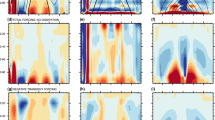Summary
The large scale three-dimensional diabatic heating in the atmosphere is computed at 12 isentropic surfaces for a particular twelve hour time period. Using a method due toErtel, the continuity equation is combined with the equations of motion to give an explicit relation between diabatic heating and changes in potential vorticity and stability along isentropic surface trajectories. The results are barely of useful accuracy and reliability and this only under favorable conditions. The distribution of diabatic heating is qualitatively reasonable in the regions near the tropopause, close to the ground, above a cloud or moist layer, and within an area of general condensation. Errors and approximations make the computed values completely unreliable in areas of large anticyclonic vorticity or large baroclinity. Comparison of magnitudes with those computed from rainfall observations and with those measured directly at the earth's surface shows agreement in sign and within a factor of three in the areas of best data. The results emphasize that there are regions and periods where diabatic heating in the free atmosphere may be important in controlling atmospheric behavior. Sample calculations in one of these regions using values of diabatic heating computed by this study illustrate that this process is of comparable importance with the adiabatic process in determining vertical velocity.
Zusammenfassung
Die großräumige nichtadiabatische Erwärmung der Atmosphäre in 12 isentropen Flächen während eines 12stündigen Zeitabschnittes wird berechnet. Unter Verwendung einer Methode vonErtel liefert eine Kombination der Kontinuitätsgleichung mit den Bewegungsgleichungen eine explizite Beziehung zwischen der nichtadiabatischen Erwärmung, der potentiellen Vorticity und der Stabilität entlang der isentropen Trajektorien. Das Resultat ist von beschränkter Genauigkeit — und auch dies nur unter günstigen Bedingungen. Qualitativ brauchbare Verteilungen der nichtadiabatischen Erwärmung erhält man nahe der Tropopause, in Bodennähe, über einer Schicht von Wolken oder feuchter Luft und innerhalb der Zonen mit verbreiteter Kondensation. In Gebieten mit großer antizyklonaler Vorticity oder großer Baroklinität werden die berechneten Werte infolge von Meß- und Approximationsfehlern völlig ungenau. In den Gebieten mit optimalen Voraussetzungen stimmen die berechneten Werte mit den aus Niederschlagsmessungen abgeleiteten oder am Boden direkt beobachteten im Vorzeichen und innerhalb eines Faktors von 3 überein. Die Ergebnisse der vorliegenden Untersuchung weisen erneut darauf hin, daß in manchen Gebieten bzw. Zeitabschnitten das Verhalten der freien Atmosphäre durch nichtadiabatische Erwärmung wesentlich beeinflußt sein kann. Stichprobenweise Berechnungen für eines dieser Gebiete zeigen, daß die theoretisch ermittelte nichtadiabatische Erwärmung für die resultierende Vertikalgeschwindigkeit der Luft quantitativ von ähnlicher Bedeutung ist wie der adiabatische Prozeß.
Résumé
L'auteur a calculé le réchauffement non adiabatique, à grande échelle, de l'atmosphère à 12 niveaux isentropes pendant un intervalle de 12 heures. Une méthode établie parErtel combine l'équation de continuité et les équations de mouvement et aboutit à une relation explicite entre le réchauffement non adiabatique, la vorticity potentielle et la stabilité le long de trajectoires isentropes. Le résultat n'a qu'une exactitude approchée, et cela dans des conditions favorables seulement. On obtient une répartition utilisable du réchauffement non adiabatique au voisinage de la tropopause, du sol, au-dessus d'une couche de nuages ou d'air humide, ainsi qu'à l'intérieur des zones à forte condensation. Dans les régions à grande vorticity anticyclonique et à grande baroclinité, les valeurs calculées deviennent tout à fait inexactes par suite d'une approximation insuffisante et d'erreurs de mesure. Dans les régions à conditions favorables par contre, les valeurs calculées correspondent à celles que l'on peut tirer de la mesure des précipitations ou de celles que l'on mesure au sol, cela au signe et à un facteur 3 près. Le résultat de cette étude montre à nouveau que dans certaines régions ou certains laps de temps l'état de l'atmosphère peut être notablement conditionné par un réchauffement non adiabatique. Des épreuves faites pour l'une de ces régions montrent que le réchauffement non adiabatique obtenu par calcul est quantitativement aussi important pour la vitesse verticale résultante de l'air que le processus adiabatique.
Similar content being viewed by others
References
Aubert, E.: On the Release of Latent Heat as a Factor in Large Scale Atmospheric Motions. J. Met.14, 527–542 (1957).
Danielsen, E.: The Laminar Structure of the Atmosphere and Its Relation to the Concept of a Tropopause. Arch. Met. Geoph. Biokl. A11, 293–332 (1959).
Danielsen, E.: Trajectories-Isobaric, Isentropic, and Actual. J. Met.18, 479–486 (1961).
Ertel, H.: Ein neuer hydrodynamischer Wirbelsatz. Met. Z.59, 277–281 (1942).
Fleagle, R. G.: Some Estimates of the Effect of Heating on Large Scale Disturbances. Tellus12, 127–133 (1960).
Manabe, S.: On the Estimation of Energy Exchange Between the Japan Sea and the Atmosphere During the Winter Based Upon the Energy Budget of Both Atmosphere and the Sea. Coll. Met. Papers9, 123–134 (1959).
Martin, D. E.: An Investigation of Systematic Errors in the Barotropic Forecasts. Tellus10, 451–465 (1958).
Ohring, G.: The Radiation Budget of the Stratosphere. J. Met.15, 440–451 (1958).
Smagorinski, J.: The Dynamical Influence of Large Scale Heat Sources and Sinks on the Quasi-stationary Mean Motions of the Atmosphere. Quart. J. Roy. Met. Soc.79, 342–366 (1953).
Suomi, V. E., D. O. Staley andP. M. Kuhn: A Direct Measurement of Infra-red Radiation Divergence to 160 mb. Quart. J. Met. Soc.84, 134–141 (1958).
Winston, J.: Physical Aspects of Rapid Cyclogenesis in the Gulf of Alaska. Tellus7, 481–500 (1955).
Author information
Authors and Affiliations
Additional information
With 7 Figures
Rights and permissions
About this article
Cite this article
Houghton, D.D. A calculation of the large scale three dimensional distribution of diabatic heating in the atmosphere. Arch. Met. Geoph. Biokl. A. 12, 407–425 (1962). https://doi.org/10.1007/BF02249275
Issue Date:
DOI: https://doi.org/10.1007/BF02249275




